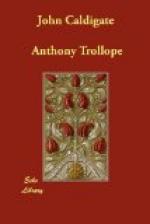also should be your story. The woman,—I
must describe her in this way lest I should do her
an injustice by calling her Mrs. Smith, or do my client
an injustice by calling her Mrs. Caldigate,—has
told you that this envelope, with an enclosure which
she produced, reached her at Nobble through the post
from Sydney. To that statement I call upon you
to give no credit. A letter so sent would, as
you have been informed, bear two postmarks, those
of Sydney and of Nobble. This envelope bears one
only. But that is not all. I shall call
before you two gentlemen experienced in affairs of
the post-office, and they will tell you that the postmarks
on this envelope, both that of the town, Sydney, and
that by which the postage stamp is obliterated, are
cleaner, finer, and better perceived than they would
have been had it passed in ordinary course through
the post-office. Letters in the post-office are
hurried quickly through the operation of stamping,
so that one passing over the other while the stamping
ink is still moist, will to some extent blot and blur
that with which it has come in contact. He will
produce some dozens taken at random, and will show
that with them all such has been the case. This
blotting, this smudging, is very slight, but it exists;
it is always there. He will tell you that this
envelope has been stamped as one and alone,—by
itself,—with peculiar care;—and
I shall ask you to believe that the impression has
been procured by fraud in the Sydney post-office.
If that be so; if in such a case as this fraud be once
discovered, then I say that the whole case will fall
to the ground, and that I shall be justified in telling
you that no word that you have heard from these four
witnesses is worthy of belief.
’Nothing worthy of belief has been adduced against
my client unless that envelope be so. That those
four persons have conspired together for the sake
of getting money is clear enough. To their evidence
I shall come presently, and shall endeavour to show
you why you should discredit them. At present
I am concerned simply with this envelope, on which
I think that the case hangs. As for the copy
of the register, it is nothing. It would be odd
indeed if in any conspiracy so much as that could
not be brought up. Had such a register been found
in the archives of any church, however humble, and
had an attested copy been produced, that would have
been much. But this is nothing. Nor is the
alleged letter from Mr. Allan anything. Were
the letter genuine it would show that such a marriage
had been contemplated, not that it had been solemnised.
We have, however, no evidence to make us believe that
the letter is genuine. But this envelope,’—and
he again stretched it out towards the jury,—’is
evidence. The impression of a post-office stamp
has often been accepted as evidence. But the evidence
may be false evidence, and it is for us to see whether
it may not probably be so now.




